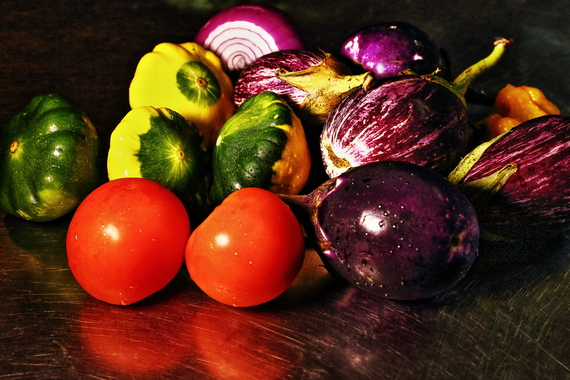I was a vegetarian for 21 years, now I am not. My wife has been a vegetarian for 21 years, earlier she was not. The cuisines which feature vegetables the best are the ones which have done so for centuries because of religious, economic, geographic, and moral factors. According to a 2012 UN FAO Study, out of 177 countries, India had the lowest annual average per person meat consumption (about 7.4 lbs.) whereas the United States had the second highest (about 250 lbs. on average per person, per year). What is most staggering about this comparison is that India's population is almost four times that of the United States. There is no denying the pressures on the land, resources, and environment of a largely animal-based diet versus that of a plant- and vegetable-based one. This piece is not meant to provide any overnight magical solutions (because frankly, there aren't any) to reduce the consumption of meat worldwide, but rather, is an attempt, from a chef's point of view, to point out some simple ways in which vegetables can be a source of dietary satisfaction, nutrition, and even preference.
1. SMOKING: Bacon, barbecue, kālua titillate the taste buds because of their deep connections to decadent and rich flavors. Smoking vegetables is an underutilized method of treating them. Season them as you would an animal protein, even marinating them overnight, and smoke them covered for a while and the uncovered. Some vegetables which are best smoked are tomatoes, cauliflower, greens, summer squash, cabbage, and onions. Generally speaking, juicy vegetables do well under this preparation. After smoking the vegetables, one can use them as is or incorporate them into other meatless dishes.
2. ROASTING: Not everyone has a smoker, but almost everyone in North America has an oven. At Cress, we roast an assortment of vegetables every day before service and they accompany many of our entrees. Roasting intensifies the flavor and showcases the natural sugars providing a tasty snack or satisfying way of incorporating the vegetables into other preparations.
3. USING SPICES: Indian cuisine better (and more) than any other specializes in the use of spices. The reason Indian cuisine is so satisfying for vegetarians worldwide is because the dishes are fraught with deep and savory flavors thanks to the knowledgeable use of spices. For the record, spicy doesn't necessarily mean hot. So, for anyone who thinks they don't like spices, perhaps, they just don't like the pungency of capsaicin. By layering the flavors of vegetables during the cooking process with a variety of spices, the end result can be both nutritious (many spices are known to have medicinal value) and delicious.
4. SAUCES: Vegetables lend themselves to be accompanied by sauces just as animal proteins do. So, instead of simply stir-frying them and accompanying them with a starch or grain, learn a repertoire of sauces which complement the flavor of the prepared vegetable. Treat the vegetable as the center-piece rather than an accompaniment.
5. SEASONALITY: In most grocery stores in the United States, many vegetables are available year-round which is unthinkable in many vegetarian-forward countries. Because the consumers demand them, they are supplied, somehow. Unfortunately, the omnipresent availability is at the expense of flavor. Staging vegetables at various levels of ripeness in temperature-controlled facilities before supplying them to the market has sucked the flavor out of most of them during the off-season. By focusing on the seasonal vegetables, one can better enjoy the benefits of their flavor and nutritional value.
At the end of the day, we can espouse all the virtues of limiting meat consumption, but by not offering some viable alternatives, the chance for a change in the tide is minimal, at best. Chefs have a tremendous role to play in this regard. I welcome that responsibility one coriander-spiced roasted cauliflower, stuffed smoked tomato with grilled ramp chimichurri at a time.
